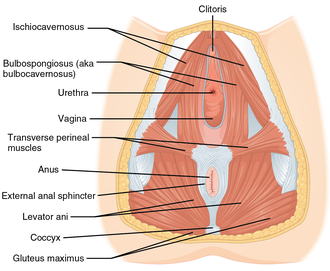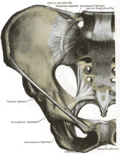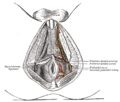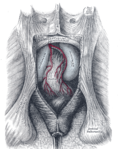Urogenital triangle
Anatomical region of the perineum
The urogenital triangle is a division of the perineum that includes the external genitalia and the openings of the urinary system. It is one of the two triangles of the perineum, the other being the anal triangle.
Anatomy
The urogenital triangle is located in the anterior part of the perineum. It is bounded by the pubic symphysis anteriorly, the ischiopubic rami laterally, and an imaginary line between the ischial tuberosities posteriorly. The triangle is oriented in a horizontal plane when the body is in the anatomical position.
Muscles
The urogenital triangle contains several important muscles, including the bulbospongiosus muscle, the ischiocavernosus muscle, and the superficial transverse perineal muscle. These muscles play a role in the function of the external genitalia and the support of the pelvic organs.
Fascia
The urogenital triangle is covered by the perineal fascia, which is divided into superficial and deep layers. The superficial fascia is further divided into a fatty layer and a membranous layer, known as Colles' fascia. The deep fascia, also known as the perineal membrane, provides support to the structures within the triangle.
Contents
In males, the urogenital triangle contains the root of the penis and the scrotum. In females, it contains the vulva, which includes the labia majora, labia minora, clitoris, and the openings of the urethra and vagina.
Function
The urogenital triangle plays a crucial role in the function of the urinary and reproductive systems. It supports the external genitalia and provides passage for the urethra and, in females, the vagina. The muscles of the urogenital triangle are involved in micturition, sexual function, and the support of pelvic organs.
Clinical significance
Injuries to the urogenital triangle can occur during childbirth, surgery, or trauma. Such injuries can affect the function of the urinary and reproductive systems and may require medical intervention.
Related pages
References
- Moore, K. L., Dalley, A. F., & Agur, A. M. R. (2013). Clinically Oriented Anatomy. Lippincott Williams & Wilkins.
- Standring, S. (2015). Gray's Anatomy: The Anatomical Basis of Clinical Practice. Elsevier Health Sciences.
Transform your life with W8MD's budget GLP-1 injections from $125.
W8MD offers a medical weight loss program to lose weight in Philadelphia. Our physician-supervised medical weight loss provides:
- Most insurances accepted or discounted self-pay rates. We will obtain insurance prior authorizations if needed.
- Generic GLP1 weight loss injections from $125 for the starting dose.
- Also offer prescription weight loss medications including Phentermine, Qsymia, Diethylpropion, Contrave etc.
NYC weight loss doctor appointments
Start your NYC weight loss journey today at our NYC medical weight loss and Philadelphia medical weight loss clinics.
- Call 718-946-5500 to lose weight in NYC or for medical weight loss in Philadelphia 215-676-2334.
- Tags:NYC medical weight loss, Philadelphia lose weight Zepbound NYC, Budget GLP1 weight loss injections, Wegovy Philadelphia, Wegovy NYC, Philadelphia medical weight loss, Brookly weight loss and Wegovy NYC
|
WikiMD's Wellness Encyclopedia |
| Let Food Be Thy Medicine Medicine Thy Food - Hippocrates |
Medical Disclaimer: WikiMD is not a substitute for professional medical advice. The information on WikiMD is provided as an information resource only, may be incorrect, outdated or misleading, and is not to be used or relied on for any diagnostic or treatment purposes. Please consult your health care provider before making any healthcare decisions or for guidance about a specific medical condition. WikiMD expressly disclaims responsibility, and shall have no liability, for any damages, loss, injury, or liability whatsoever suffered as a result of your reliance on the information contained in this site. By visiting this site you agree to the foregoing terms and conditions, which may from time to time be changed or supplemented by WikiMD. If you do not agree to the foregoing terms and conditions, you should not enter or use this site. See full disclaimer.
Credits:Most images are courtesy of Wikimedia commons, and templates, categories Wikipedia, licensed under CC BY SA or similar.
Contributors: Prab R. Tumpati, MD










